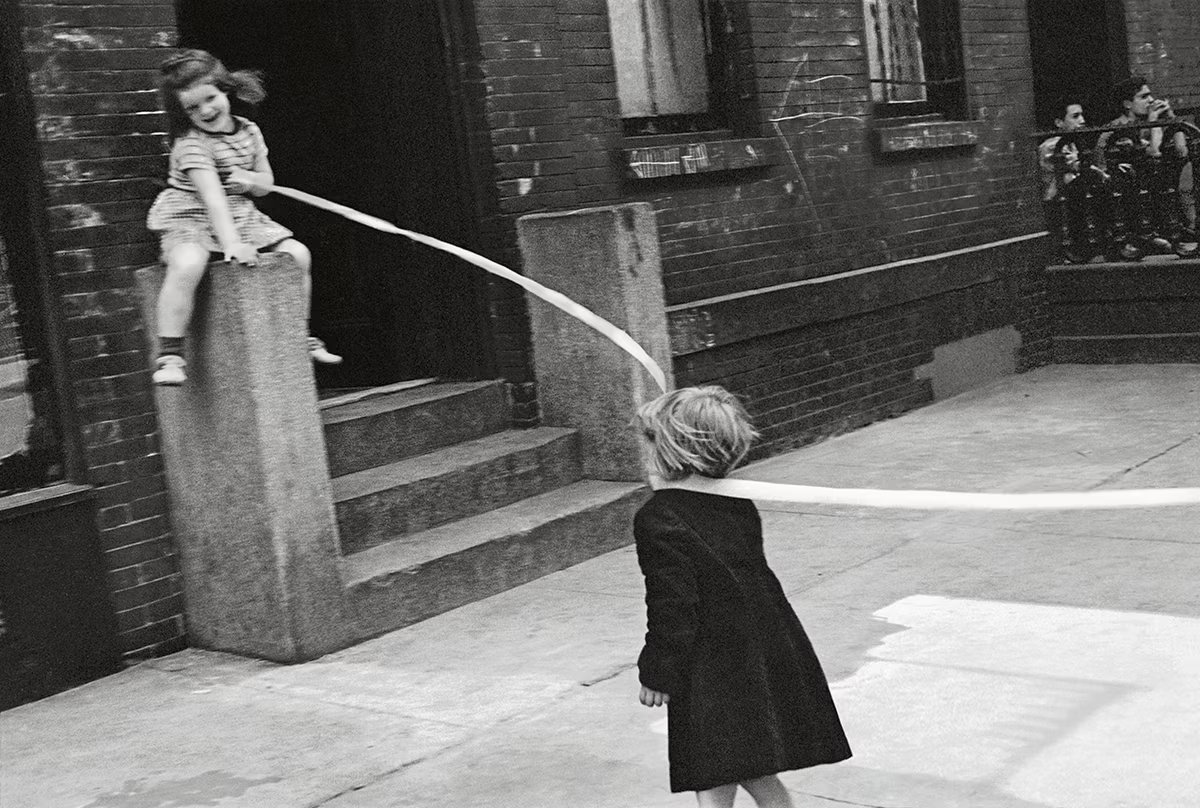Helen Levitt: One Two Three More
Helen Levitt’s One Two Three More is a poetic exploration of street life, revealing her mastery in capturing the spontaneous choreography of the everyday. Through her lens, Levitt documented the raw, unfiltered vibrancy of urban streets, elevating ordinary moments into extraordinary visual narratives.

A Quick Biography
Helen Levitt (1913–2009) was an American photographer born and raised in Brooklyn, New York. She began her career as a commercial portrait photographer but soon turned to the streets, finding inspiration in the everyday life of her city. In the late 1930s, she apprenticed briefly with Walker Evans and was deeply influenced by Henri Cartier-Bresson’s pioneering street photography. Helen Levitt is considered one of the first and most influential female street photographers.
Levitt’s first major break came in 1943 when her black-and-white images of New York’s streets were exhibited at the Museum of Modern Art (MoMA). Over her career, she transitioned from black-and-white to color photography, using the vibrancy of color to further enhance her depictions of urban life. Her work graced the pages of Life magazine and appeared in exhibitions worldwide, cementing her reputation as one of the most influential street photographers of the 20th century.

A Visionary of the Streets
Helen Levitt carved her place in photographic history by focusing on the overlooked details of life in New York City. Her unique approach to street photography captured fleeting interactions, moments of play, and the inherent beauty of chaos. One Two Three More is a culmination of her decades-long journey into the heart of urban existence, showcasing her signature style of visual storytelling.
Key Themes in One Two Three More
- Playfulness
Children dominate many of Levitt’s photographs, embodying the uninhibited spirit of creativity. From chalk drawings on sidewalks to spontaneous games, her images are a celebration of youthful imagination. - Urban Theatrics
Levitt saw the streets as a stage, where strangers performed unknowingly. Her compositions often freeze interactions, gestures, and expressions that feel both candid and choreographed. - Everyday Elegance
Levitt’s work transforms the mundane into the magnificent. A simple gesture, a fleeting glance, or an abstract shadow becomes art under her watchful eye.

The Power of Silence
Levitt rarely titled her images or provided context, leaving interpretation to the viewer. This deliberate ambiguity invites us to engage with her work emotionally, fostering a connection that transcends time and place. One Two Three More exemplifies this approach, creating a narrative that is universal yet deeply personal.
“The streets were her theater, and her photography was the script.”
— Anonymous Critic on Helen Levitt’s Work
Levitt’s Mastery of Color and Black-and-White
While Levitt is best known for her black-and-white images, One Two Three More highlights her foray into color photography. Her color work adds a new dimension to her storytelling, capturing the textures and hues of the urban environment in ways that black-and-white could not. Yet, both styles share her impeccable timing and sense of composition.

Why One Two Three More Matters
This book is not merely a collection of images; it is a meditation on the beauty of fleeting moments. Levitt’s ability to find harmony in chaos resonates with photographers and viewers alike, reminding us of the poetry in our everyday surroundings.
Key Takeaways from One Two Three More
- Be Present: Levitt’s work teaches us to observe our surroundings with an open mind and a curious eye.
- Embrace Imperfection: Her photographs remind us that beauty often lies in the unpolished and unscripted.
- Find Joy in the Ordinary: By elevating everyday moments, Levitt inspires us to seek wonder in our daily lives.
Conclusion
Helen Levitt’s One Two Three More is a masterpiece of street photography, blending humor, poignancy, and raw humanity. It challenges us to slow down, to look closer, and to appreciate the subtle stories unfolding around us. Levitt’s work is a timeless reminder that the streets are alive with drama, beauty, and meaning—if only we have the eyes to see it.
Further Reading:
- Helen Levitt’s A Way of Seeing
- Documentary: In the Street
- Exploring Urban Photography